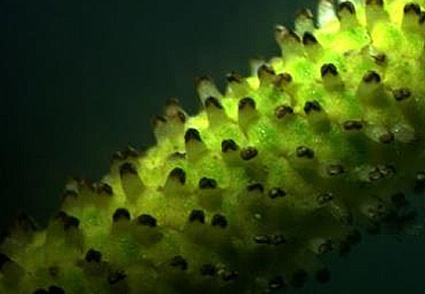Abstract
Piper kiminensis (Piperaceae), a new species, is described from Arunachal Pradesh, northeastern India, along with notes on its habitat, ecology, and conservation status. A dioecious, semi-woody climber with distinct dimorphic branches, it is distinguished from other climbing pipers by its vegetative branches possessing shingled, variegated leaves. The new species does share some similarities with P. obtusissimum in its vegetative branches and P. betleoides in its fertile branches, so a table with detailed morphological features for all three species is provided for easy comparison. For aid in recognition, color photographs are also included. The molecular studies based on the ITS sequence also confirmed the distinctness of the new species from other taxa. Moreover, it shows little similarity with any of the existing Piper species.
References
- Ankenbrand, M.J., Keller, A., Wolf, M., Schultz, J. & Förster, F. (2015) ITS2 database V: Twice as much. Molecular Biology and Evolution 32 (11): 3030–3032. https://doi.org/10.1093/molbev/msv174
- Altschul, S.F., Gish, W., Miller, W., Myers, E.W. & Lipman, D.J. (1990) Basic local alignment search tool. Journal of Molecular Biology 215 (3): 403–410. https://doi.org/10.1016/S0022-2836(05)80360-2
- Asmarayani, R. (2018) Phylogenetic relationships in Malesian-Pacific Piper (Piperaceae) and their implications for systematics. Taxon 67: 693–724. https://doi.org/10.12705/674.2
- Candolle, A.P. de (1869) Prodromus Systematis Naturalis Regni Vegetabilis, volume 16 (1). Treuttel & Wurtz, Paris, pp. 348–349. https://doi.org/10.12705/674.2
- Candolle, C. de (1923) Piperacearum clavis analytica. Candollea 1: 186. https://doi.org/10.5962/bhl.title.15548
- DNA Sequence Assembler v4 (2013) HeracleBioSoft. Available from: www.dnabaser.com (accessed 20 February 2025)
- Gajurel, P.R., Rethy, P., Kumar, Y. & Singh, B. (2008) Piper species (Piperaceae) of North-East India (Arunachal Pradesh). Bishen Singh Mahendra Pal Singh, Dehra Dun.
- Gajurel, P.R. & Lua, H.K. (2020) Flora of Singapore precursors, 20: Notes on the genus Piper (Piperaceae) from Singapore. Gardens’ Bulletin Singapore 72: 135–141. https://doi.org/10.26492/gbs72(2).2020-02
- Hooker, J.D. (1886) Flora of British India, volume 5. L. Reeve & Co., Ashford, Kent, London, 87 pp.
- Huang, A. (1990) A new species of Piper Linn. from Hainan. Guihaia 10 (4): 295–295.
- IUCN (2012) The IUCN red list categories and criteria, version 3.1. IUCN, Gland, Switzerland.
- Jain, S.K. & Rao, R.R. (1977) A handbook of field and herbarium methods. Today and Tomorrow’s Printers and Publishers, New Delhi.
- Jaramillo, M.A., Callejas, R., Davidson, C., Smith, J.F.,Stevens, A.C. & Tepe, E.J. (2008) A phylogeny of the tropical genus Piper using ITS and the chloroplast intron psbj-petA. Systematic Botany 33: 647–660. https://doi.org/10.1600/036364408786500244
- Linnaeus, C. von. (1753) Species Plantarum, volume 1. Impensis Laurentii Salvii, Holmiae, Stockholm, 28 pp.
- Miquel, F.A.W. (1843) Systema piperacearum. Apud H. A. Kramers. Roterodami, 337 pp. https://doi.org/10.5962/bhl.title.151
- Quijano-Abril, M.A., Callejas-Posada, R. & Miranda-Esquivel, D.R. (2006) Areas of endemism and distribution patterns for neotropical Piper species (Piperaceae). Journal of Biogeography 33: 1266–1278. http://dx.doi.org/10.1111/j.1365-2699.2006.01501.x
- Ridley, H.N. (1920) New and rare species of Malayan plants. Journal of the Straits Branch of the Royal Asiatic Society 82: 167–204. https://doi.org/10.1111/j.1365-2699.2006.01501.x
- Ridley, H.N. (1924) The Flora of the Malay Peninsula, Vol. 4. Reeve, London.
- Roxburgh, W. (1814) Hortus Bengalensis, or A cataloguen of the plants growing in the Honourable East India Company’s botanic garden at Calcutta. Serampore mission press, 80 pp.
- Sayers, E.W., Bolton, E.E., Brister, J.R., Canese, K., Chan, J., Comeau, D.C., Connor, R., Funk, K., Kelly, C., Kim, S., Madej, T., Marchler-Bauer, A., Lanczycki, C., Lathrop, S., Lu, Z., Thibaud-Nissen, F., Murphy, T., Phan, L., Skripchenko, Y., Tse, T., Wang, J., Williams, R., Trawick, B.W., Pruitt, K.D. & Sherry, S.T. (2022) Database resources of the national center for biotechnology information. Nucleic Acids Research 50 (D1): D20–D26. https://doi.org/10.1093/nar/gkab1112
- Seemann, B. & Fitch, W.H. (1865) Flora vitiensis: a description of the plants of the Viti or Fiji islands, with an account of their history, uses, and properties, volume 1. L. Reeve., London, 262 pp. https://doi.org/10.5962/t.174884
- Sen, S., Dayanandan, S., Davis, T., Ganesan, R., Jagadish, M.R., Mathew, P.J. & Ravikanth, G. (2019) Origin and evolution of the genus Piper in Peninsular India. Molecular Phylogenetics and Evolution 138: 102–113. https://doi.org/10.1016/j.ympev.2019.05.033
- Simmonds, S.E., Smith, J.F., Davidson, C. & Buerki, S. (2021) Phylogenetics and comparative plastome genomics of two of the largest genera of angiosperms, Piper and Peperomia (Piperaceae). Molecular Phylogenetics and Evolution 163: 107229. https://doi.org/10.1016/j.ympev.2021.107229
- Soltis, P.A., Soltis, D.E. & Chase, M.W. (1999) Angiosperm phylogeny inferred from multiple genes as a tool for comparative biology. Nature 402: 402–404. https://doi.org/10.1038/46528
- Suwanphakdee, C., Karapan, S., Banchong, Y. & Hodkinson, T.R. (2023) Three new species, two new records and additional taxonomic notes of Piper (Piperaceae) from Thailand. Nordic Journal of Botany 11: 1–19. https://doi.org/10.1111/njb.04099
- Tamura, K., Stecher, G. & Kumar, S. (2021) MEGA11: Molecular Evolutionary Genetics Analysis version 11. Molecular Biology and Evolution 38: 3022–3027. https://doi.org/10.1093/molbev/msab120
- Tebbs, M.C. (1993) Piperaceae. In: Kubitzki, K., Rohwer, J.G. & Bittrich, V. (Eds.) The Families and Genera of Vascular Plants. II. Flowering Plants: Dicotyledons, Magnoliid, Hamamelid and Caryophyllid Families. Springer, Berlin, pp. 516–520. https://doi.org/10.1007/978-3-662-02899-5_60
- Thiers, B.M. (2025 [updated continuously]) Index Herbariorum: A global directory of public herbaria and associated staff. New York Botanical Garden’s Virtual Herbarium. Available from: https://sweetgum.nybg.org/science/ih/ (accessed 20 February 2025)


